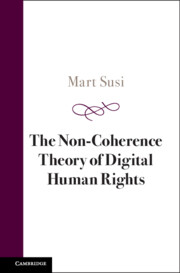Book contents
- The Non-coherence Theory of Digital Human Rights
- The Non-coherence Theory of Digital Human Rights
- Copyright page
- Contents
- Acknowledgements
- Introduction
- Part I The Contextual Challenges and Purpose of the Non-coherence Theory of Digital Human Rights
- Part II Reflections on Some Theories and Doctrines
- Part III The Core Elements of Non-coherence Theory
- Part IV The Impact of the Non-coherence Theory
- 18 The E-state and Fundamental Rights
- 19 Proportionality Deficit Paradox
- 20 Automated Systems and Artificial Intelligence
- Part V Internet Balancing Formula
- In Lieu of the Concluding Remarks
- Index
19 - Proportionality Deficit Paradox
from Part IV - The Impact of the Non-coherence Theory
Published online by Cambridge University Press: 22 February 2024
- The Non-coherence Theory of Digital Human Rights
- The Non-coherence Theory of Digital Human Rights
- Copyright page
- Contents
- Acknowledgements
- Introduction
- Part I The Contextual Challenges and Purpose of the Non-coherence Theory of Digital Human Rights
- Part II Reflections on Some Theories and Doctrines
- Part III The Core Elements of Non-coherence Theory
- Part IV The Impact of the Non-coherence Theory
- 18 The E-state and Fundamental Rights
- 19 Proportionality Deficit Paradox
- 20 Automated Systems and Artificial Intelligence
- Part V Internet Balancing Formula
- In Lieu of the Concluding Remarks
- Index
Summary
Non-coherence theory says the boundaries of traditional fundamental rights either become broader or narrower once transposed into the digital context, and this has also been shown previously. There are two images which at first sight appear almost the opposite of one another. The first reflects almost total freedom of expression unrestrained in practice, and the second almost the total absence of such freedom due to e-technologies which have the function of transparency and perpetuating everything which has been recorded or done. The first is a feature of social media and the second of blockchain technologies. These images may seem incompatible but are additionally explainable through the proportionality deficit paradox. Proportionality as a human rights instrument becomes distorted and weakened in the digital domain. The fragmentation stems from the loss of its holistic capacity to be applied anywhere relative rights collide online. The distortion means a breakage of the link between the outcome and the proportionality principle. The concept of proportionality between online and offline human rights domains exhibits wide non-coherence.
Keywords
- Type
- Chapter
- Information
- The Non-Coherence Theory of Digital Human Rights , pp. 225 - 231Publisher: Cambridge University PressPrint publication year: 2024

